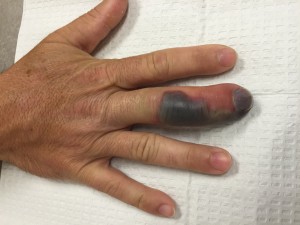
Copperhead bite to finger
Most snakes in North Carolina are non-venomous. These snakes are not dangerous to humans. The two families of venomous snakes in North Carolina include the Viperidea and Elapidae families. The Copperhead, Cottonmouth (often called “water moccasins”), Eastern Diamondback, and Timber Rattlesnake are examples of pit vipers in the Viperidea Family. Pit Vipers make up approximately 98% of the venomous snake bites in the United States. The Eastern Coral Snake is the only snake in the Elapidae Family native to North Carolina, and it is much less common than pit vipers.
If you are bitten by a snake, call 9-1-1 or go to the nearest emergency room. Wash the bite area with soap and water and cover with a clean bandage. While you are awaiting medical attention, sit down and stay calm because accelerating your heart rate can spread the venom. Try to remember the color and markings of the snake or take a photograph for identification. Do not attempt to capture the snake.
Forget what you may have heard. Here are the Dos and Don’ts after a snake bite:
- Do not kill or capture the snake, as this may result in another bite
- Do not apply a tourniquet
- Do not apply ice
- Do not cut the bite open with a knife
- Do not suck the venom out
- Do not drink alcohol after the snake bite
- Go to the nearest emergency room
Pit viper venom is well-known for its toxicity especially to blood vessels and soft tissues. This causes intense pain, redness, swelling, bruising, and blistering in the area within a few minutes after the bite. The toxin can also result in life-threatening abnormalities in heart, lung, kidney, blood clotting, and nervous system function. Coral snake venom is also very toxic, especially to the nervous system. Neurologic symptoms after a coral snake bite can be delayed, so seek medical attention promptly, even if you feel fine at first.
In the emergency room, doctors should assess vital signs including respiratory rate, heart rate and blood pressure for several hours and evaluate for “envenomation syndrome”. Blood tests are usually obtained to evaluate electrolytes, red blood cell count, platelet count, kidney function and blood clotting factors. If the patient shows signs of instability, he or she is transferred to a critical care unit for resuscitation and treatment. Additionally, if there are signs of a serious toxic response from a pit viper bite, antivenin medicine called CroFab can be given intravenously. The bite wounds are cleaned, tetanus prophylaxis is updated, and the hand and arm are monitored for swelling and blood flow. If swelling in the hand or arm is severe, surgery may occasionally be necessary to decompress muscle compartments to prevent further damage to the limb. Surgery may be needed to remove devitalized tissues and reconstruct the skin. Once the patient is stabilized medically, wound care, hand therapy and rehabilitation are important to regain function of the hand and arm.
